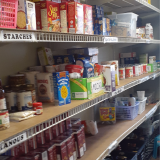Sports Led the Way: Integration at Belton-Honea Path High School, South Carolina
Story Narrative:
In 1966, football became the first integrated sport at the newly founded Belton-Honea Path High School. Head Coach Sonny King and former players JE Palmer and Ronald Wilson recall the hard workouts and winning games that overcame not only division of the races, but of the communities as well.
This documentary was created by 5th graders at Belton Elementary School as part of a Stories from Main Street Youth Access Project.
Media Files:
-
Integration at Belton Honea Path High School, South Carolina



